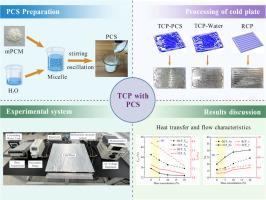拓扑优化冷板相变浆料传热与流动特性实验研究
IF 5.8
2区 工程技术
Q1 ENGINEERING, MECHANICAL
International Journal of Heat and Mass Transfer
Pub Date : 2025-10-15
DOI:10.1016/j.ijheatmasstransfer.2025.127955
引用次数: 0
摘要
冷板液体冷却为电池热管理提供了有效的解决方案。然而,传统冷板设计的几何限制和传统单相流体依靠显热蓄热的局限性阻碍了其实际应用。本研究通过将拓扑优化冷板(TCP)与相变浆料(PCS)相结合来解决这些挑战,并通过实验研究了其在设计和非设计条件下的适应性。建立实验平台,全面研究了TCP中PCS的蓄热特性,以及冷板配置、进口温度、体积流量和质量浓度对PCS流动和换热特性的影响。结果表明,与水相比,聚碳酸酯具有更好的储热性能,这主要归功于其增强的潜热吸收能力。与矩形通道冷板(RCP)相比,TCP实现了8.6°C的最高温度降低。在20wt % PCS条件下,TCP的PEC数是RCP的1.3倍,突出了其在设计和非设计条件下的传热增强和流动阻力降低方面的整体性能。在24°C时,由于相变过程中的有效吸热,即使在非设计条件下,20 wt% PCS也能达到较低的Tave和Tδ。随着Qv的增大,质量浓度对平均温度的影响减小。在设计工况和非设计工况下,PCS的流动阻力系数均大于纯水,这是由于PCS的粘度增加所致。本研究可为进一步研究和实际应用提供实验支持和技术参考。本文章由计算机程序翻译,如有差异,请以英文原文为准。

Experimental study on the heat transfer and flow characteristics of phase change slurry in topology optimization cold plate
Liquid cooling with cold plates offers an efficient solution for battery thermal management. However, the geometric limitations of traditional cold plate designs and the limitations of conventional single-phase fluids relying on the sensible heat for heat storage hinder its practical application. This study addresses these challenges by combining the topology optimization cold plate (TCP) with phase change slurry (PCS), and experimentally investigates its adaptability at both design and off-design conditions. An experimental platform is established to comprehensively investigate the thermal energy storage characteristic of PCS and the effects of cold plate configuration, inlet temperature, volume flow rate and mass concentration on the flow and heat transfer characteristics of PCS in TCP. The results demonstrate that the PCS demonstrates superior thermal energy storage performance compared to water, primarily attributed to its enhanced latent heat absorption capacity. TCP achieves an 8.6 °C reduction for the maximum temperature compared to the rectangular channel cold plate (RCP). The PEC number for TCP is 1.3 times that of RCP at 20 wt% PCS, highlighting its overall better performance in heat transfer enhancement and flow resistance reduction at both design and off-design conditions. At 24 °C, 20 wt% PCS achieves the lower Tave and Tδ due to effective heat absorption during phase change process even at the off-design condition. As the Qv increases, the influence of mass concentration on the average temperature diminishes. At both design and off-design conditions, all the flow resistance factors of PCS are larger than that of pure water, attributing to the increase of PCS viscosity. This study can provide experimental support and technical reference for further research and practical application.
求助全文
通过发布文献求助,成功后即可免费获取论文全文。
去求助
来源期刊
CiteScore
10.30
自引率
13.50%
发文量
1319
审稿时长
41 days
期刊介绍:
International Journal of Heat and Mass Transfer is the vehicle for the exchange of basic ideas in heat and mass transfer between research workers and engineers throughout the world. It focuses on both analytical and experimental research, with an emphasis on contributions which increase the basic understanding of transfer processes and their application to engineering problems.
Topics include:
-New methods of measuring and/or correlating transport-property data
-Energy engineering
-Environmental applications of heat and/or mass transfer

 求助内容:
求助内容: 应助结果提醒方式:
应助结果提醒方式:


